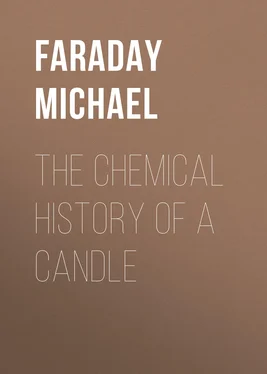Michael Faraday - The Chemical History of a Candle
Здесь есть возможность читать онлайн «Michael Faraday - The Chemical History of a Candle» — ознакомительный отрывок электронной книги совершенно бесплатно, а после прочтения отрывка купить полную версию. В некоторых случаях можно слушать аудио, скачать через торрент в формате fb2 и присутствует краткое содержание. Жанр: foreign_edu, Химия, на английском языке. Описание произведения, (предисловие) а так же отзывы посетителей доступны на портале библиотеки ЛибКат.
- Название:The Chemical History of a Candle
- Автор:
- Жанр:
- Год:неизвестен
- ISBN:нет данных
- Рейтинг книги:4 / 5. Голосов: 1
-
Избранное:Добавить в избранное
- Отзывы:
-
Ваша оценка:
- 80
- 1
- 2
- 3
- 4
- 5
The Chemical History of a Candle: краткое содержание, описание и аннотация
Предлагаем к чтению аннотацию, описание, краткое содержание или предисловие (зависит от того, что написал сам автор книги «The Chemical History of a Candle»). Если вы не нашли необходимую информацию о книге — напишите в комментариях, мы постараемся отыскать её.
The Chemical History of a Candle — читать онлайн ознакомительный отрывок
Ниже представлен текст книги, разбитый по страницам. Система сохранения места последней прочитанной страницы, позволяет с удобством читать онлайн бесплатно книгу «The Chemical History of a Candle», без необходимости каждый раз заново искать на чём Вы остановились. Поставьте закладку, и сможете в любой момент перейти на страницу, на которой закончили чтение.
Интервал:
Закладка:
Then, there is another point about these candles which will answer a question,—that is, as to the way in which this fluid gets out of the cup, up the wick, and into the place of combustion. You know that the flames on these burning wicks in candles made of beeswax, stearin, or spermaceti, do not run down to the wax or other matter, and melt it all away, but keep to their own right place. They are fenced off from the fluid below, and do not encroach on the cup at the sides. I cannot imagine a more beautiful example than the condition of adjustment under which a candle makes one part subserve to the other to the very end of its action. A combustible thing like that, burning away gradually, never being intruded upon by the flame, is a very beautiful sight; especially when you come to learn what a vigorous thing flame is—what power it has of destroying the wax itself when it gets hold of it, and of disturbing its proper form if it come only too near.
But how does the flame get hold of the fuel? There is a beautiful point about that— capillary attraction 4 4 Capillary attraction or repulsion is the cause which determines the ascent or descent of a fluid in a capillary tube. If a piece of thermometer tubing, open at each end, be plunged into water, the latter will instantly rise in the tube considerably above its external level. If, on the other hand, the tube be plunged into mercury, a repulsion instead of attraction will be exhibited, and the level of the mercury will be lower in the tube than it is outside.
. "Capillary attraction!" you say,—"the attraction of hairs." Well, never mind the name: it was given in old times, before we had a good understanding of what the real power was. It is by what is called capillary attraction that the fuel is conveyed to the part where combustion goes on, and is deposited there, not in a careless way, but very beautifully in the very midst of the centre of action which takes place around it. Now, I am going to give you one or two instances of capillary attraction. It is that kind of action or attraction which makes two things that do not dissolve in each other still hold together. When you wash your hands, you wet them thoroughly; you take a little soap to make the adhesion better, and you find your hand remains wet. This is by that kind of attraction of which I am about to speak. And, what is more, if your hands are not soiled (as they almost always are by the usages of life), if you put your finger into a little warm water, the water will creep a little way up the finger, though you may not stop to examine it. I have here a substance which is rather porous—a column of salt—and I will pour into the plate at the bottom, not water, as it appears, but a saturated solution of salt which cannot absorb more; so that the action which you see will not be due to its dissolving anything. We may consider the plate to be the candle, and the salt the wick, and this solution the melted tallow. (I have coloured the fluid, that you may see the action better.) You observe that, now I pour in the fluid, it rises and gradually creeps up the salt higher and higher; and provided the column does not tumble over, it will go to the top.
If this blue solution were combustible, and we were to place a wick at the top of the salt, it would burn as it entered into the wick. It is a most curious thing to see this kind of action taking place, and to observe how singular some of the circumstances are about it. When you wash your hands, you take a towel to wipe off the water; and it is by that kind of wetting, or that kind of attraction which makes the towel become wet with water, that the wick is made wet with the tallow. I have known some careless boys and girls (indeed, I have known it happen to careful people as well) who, having washed their hands and wiped them with a towel, have thrown the towel over the side of the basin, and before long it has drawn all the water out of the basin and conveyed it to the floor, because it happened to be thrown over the side in such a way as to serve the purpose of a syphon. 5 5 The late Duke of Sussex was, we believe, the first to shew that a prawn might be washed upon this principle. If the tail, after pulling off the fan part, be placed in a tumbler of water, and the head be allowed to hang over the outside, the water will be sucked up the tail by capillary attraction, and will continue to run out through the head until the water in the glass has sunk so low that the tail ceases to dip into it.
That you may the better see the way in which the substances act one upon another, I have here a vessel made of wire gauze filled with water, and you may compare it in its action to the cotton in one respect, or to a piece of calico in the other. In fact, wicks are sometimes made of a kind of wire gauze. You will observe that this vessel is a porous thing; for if I pour a little water on to the top, it will run out at the bottom. You would be puzzled for a good while if I asked you what the state of this vessel is, what is inside it, and why it is there? The vessel is full of water, and yet you see the water goes in and runs out as if it were empty. In order to prove this to you, I have only to empty it. The reason is this,—the wire, being once wetted, remains wet; the meshes are so small that the fluid is attracted so strongly from the one side to the other, as to remain in the vessel although it is porous. In like manner the particles of melted tallow ascend the cotton and get to the top; other particles then follow by their mutual attraction for each other, and as they reach the flame they are gradually burned.
Here is another application of the same principle. You see this bit of cane. I have seen boys about the streets, who are very anxious to appear like men, take a piece of cane, and light it and smoke it, as an imitation of a cigar. They are enabled to do so by the permeability of the cane in one direction, and by its capillarity. If I place this piece of cane on a plate containing some camphin (which is very much like paraffin in its general character), exactly in the same manner as the blue fluid rose through the salt will this fluid rise through the piece of cane. There being no pores at the side, the fluid cannot go in that direction, but must pass through its length. Already the fluid is at the top of the cane: now I can light it and make it serve as a candle. The fluid has risen by the capillary attraction of the piece of cane, just as it does through the cotton in the candle.
Now, the only reason why the candle does not burn all down the side of the wick is, that the melted tallow extinguishes the flame. You know that a candle, if turned upside down, so as to allow the fuel to run upon the wick, will be put out. The reason is, that the flame has not had time to make the fuel hot enough to burn, as it does above, where it is carried in small quantities into the wick, and has all the effect of the heat exercised upon it.
There is another condition which you must learn as regards the candle, without which you would not be able fully to understand the philosophy of it, and that is the vaporous condition of the fuel. In order that you may understand that, let me shew you a very pretty, but very common-place experiment. If you blow a candle out cleverly, you will see the vapour rise from it. You have, I know, often smelt the vapour of a blown-out candle—and a very bad smell it is; but if you blow it out cleverly, you will be able to see pretty well the vapour into which this solid matter is transformed. I will blow out one of these candles in such a way as not to disturb the air around it, by the continuing action of my breath; and now, if I hold a lighted taper two or three inches from the wick, you will observe a train of fire going through the air till it reaches the candle. I am obliged to be quick and ready, because, if I allow the vapour time to cool, it becomes condensed into a liquid or solid, or the stream of combustible matter gets disturbed.
Читать дальшеИнтервал:
Закладка:
Похожие книги на «The Chemical History of a Candle»
Представляем Вашему вниманию похожие книги на «The Chemical History of a Candle» списком для выбора. Мы отобрали схожую по названию и смыслу литературу в надежде предоставить читателям больше вариантов отыскать новые, интересные, ещё непрочитанные произведения.
Обсуждение, отзывы о книге «The Chemical History of a Candle» и просто собственные мнения читателей. Оставьте ваши комментарии, напишите, что Вы думаете о произведении, его смысле или главных героях. Укажите что конкретно понравилось, а что нет, и почему Вы так считаете.





![Евгений Матерёв - Музеи… или вдохновляющая музыка The Chemical Brothers [litres самиздат]](/books/437288/evgenij-materev-muzei-ili-vdohnovlyayuchaya-muzyka-th-thumb.webp)






